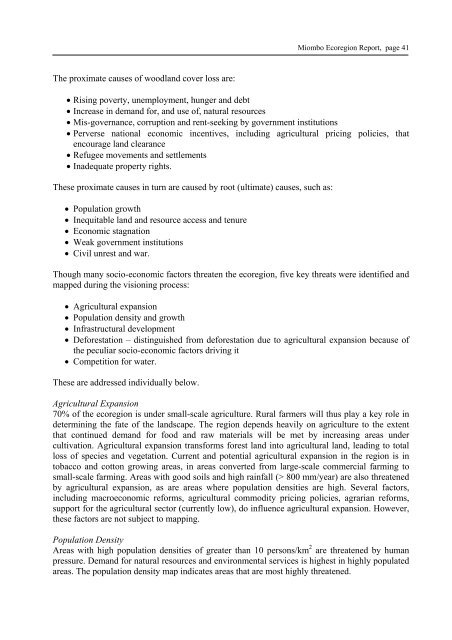Miombo Ecoregion Vision Report - Biodiversity Foundation for Africa
Miombo Ecoregion Vision Report - Biodiversity Foundation for Africa
Miombo Ecoregion Vision Report - Biodiversity Foundation for Africa
Create successful ePaper yourself
Turn your PDF publications into a flip-book with our unique Google optimized e-Paper software.
The proximate causes of woodland cover loss are:<br />
<strong>Miombo</strong> <strong>Ecoregion</strong> <strong>Report</strong>, page 41<br />
� Rising poverty, unemployment, hunger and debt<br />
� Increase in demand <strong>for</strong>, and use of, natural resources<br />
� Mis-governance, corruption and rent-seeking by government institutions<br />
� Perverse national economic incentives, including agricultural pricing policies, that<br />
encourage land clearance<br />
� Refugee movements and settlements<br />
� Inadequate property rights.<br />
These proximate causes in turn are caused by root (ultimate) causes, such as:<br />
� Population growth<br />
� Inequitable land and resource access and tenure<br />
� Economic stagnation<br />
� Weak government institutions<br />
� Civil unrest and war.<br />
Though many socio-economic factors threaten the ecoregion, five key threats were identified and<br />
mapped during the visioning process:<br />
� Agricultural expansion<br />
� Population density and growth<br />
� Infrastructural development<br />
� De<strong>for</strong>estation – distinguished from de<strong>for</strong>estation due to agricultural expansion because of<br />
the peculiar socio-economic factors driving it<br />
� Competition <strong>for</strong> water.<br />
These are addressed individually below.<br />
Agricultural Expansion<br />
70% of the ecoregion is under small-scale agriculture. Rural farmers will thus play a key role in<br />
determining the fate of the landscape. The region depends heavily on agriculture to the extent<br />
that continued demand <strong>for</strong> food and raw materials will be met by increasing areas under<br />
cultivation. Agricultural expansion trans<strong>for</strong>ms <strong>for</strong>est land into agricultural land, leading to total<br />
loss of species and vegetation. Current and potential agricultural expansion in the region is in<br />
tobacco and cotton growing areas, in areas converted from large-scale commercial farming to<br />
small-scale farming. Areas with good soils and high rainfall (> 800 mm/year) are also threatened<br />
by agricultural expansion, as are areas where population densities are high. Several factors,<br />
including macroeconomic re<strong>for</strong>ms, agricultural commodity pricing policies, agrarian re<strong>for</strong>ms,<br />
support <strong>for</strong> the agricultural sector (currently low), do influence agricultural expansion. However,<br />
these factors are not subject to mapping.<br />
Population Density<br />
Areas with high population densities of greater than 10 persons/km 2 are threatened by human<br />
pressure. Demand <strong>for</strong> natural resources and environmental services is highest in highly populated<br />
areas. The population density map indicates areas that are most highly threatened.


